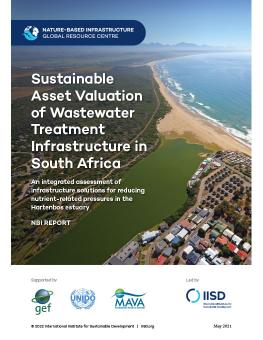
Sustainable Asset Valuation of Wastewater Treatment Infrastructure in South Africa
An integrated assessment of infrastructure solutions for reducing nutrient-related pressures in the Hartenbos estuary
This report presents the results of a Sustainable Asset Valuation (SAVi) assessment for wastewater treatment infrastructure in South Africa. Specifically, the study analyzes different wastewater treatment options for improving water quality in the Hartenbos estuary. It also explores opportunities for reusing water for irrigation and related impacts on nutrient loads to the estuary.
-
Recycling treated wastewater for irrigation offers considerable benefits for climate adaptation and the agriculture sector. Reusing 50% of the water by 2060 would cover the water demand of 330 additional hectares of agricultural land, resulting in higher water security, agricultural productivity, and job creation.
-
The economic viability of the wetland option depends on whether its implementation increases habitat quality and biodiversity, which in turn attracts additional tourists relative to the baseline. Practically, when ecological and tourism benefits are considered, the wetland is the most economical option; when these are excluded, it is the least economical option.
-
The results of the analysis illustrate that planners and policy-makers need to carefully consider the benefits and trade-offs of different infrastructure options for wastewater treatment. While the hybrid solution performs best for reducing nutrient pollution, the potential to create additional revenues from tourism through the implementation of the artificial wetland would result in even higher net benefits relative to the hybrid option.
The results of this assessment provide an overview of the societal costs and benefits of different water treatment options, considering outcomes for citizens, businesses, Mossel Bay Municipality, and the Western Cape Government. The comparative valuation provides several insights. Examples of research questions include: how efficient are the different technologies for treating the wastewater, and what contribution would they provide to the water quality of the Hartenbos estuary? Do the different options comply with national water quality standards? What would be the direct and indirect economic outcomes of improving water quality and recycling water? These questions (and more) are answered in this SAVi assessment.
You might also be interested in
How Can We Work With Nature to Tackle Drought and Desertification?
Drought is one of the most devastating and pervasive challenges exacerbated by climate change. However, we can work to reduce its effects through nature-based solutions for land restoration and climate-smart agriculture.
IISD Annual Report 2022–2023
At IISD, we’ve been working for more than three decades to create a world where people and the planet thrive. As the climate crisis unfolds on our doorsteps and irreversible tipping points loom, our team has been focused more than ever on impact.
Restoring Wetland Ecosystems in La Mojana, Colombia
This economic valuation highlights the benefits of restoring wetland ecosystems in La Mojana, Colombia, for flood protection and sustainable development.
Sustainable Asset Valuation of Land Restoration in Sodo District, Southern Ethiopia
This report presents a SAVi assessment that quantifies the social, economic, and environmental outcomes of assisted natural regeneration in Ethiopia.